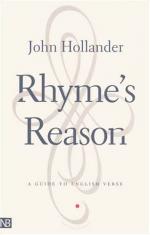|
This section contains 1,038 words (approx. 3 pages at 400 words per page) |

|
Rhyme
Rhyme can be an important element of verse, Hollander explains, but it can also detract from the poem if done badly. On page 14, he addresses the subject in an extended poem made up of couplets.
Rhymes that are too obvious weaken the effect, he explains:
The weakest way in which two words can chime
Is with the most expected kind of rhyme -
(If it's the only rhyme that you can write,
A homophone will never sound quite right.)
It is better when rhymes are not too predictable. Rhyming words of different types or different parts of speech can add some unpredictability to the verse, strengthening the poem.
Rhyme can also be used to indicate the end of a phrase or line, or it can be used to connect two parts of a continuous sentence, as in:
Like a typewriter's final, right-hand bell,
A rhyme can stop a...
|
This section contains 1,038 words (approx. 3 pages at 400 words per page) |

|




